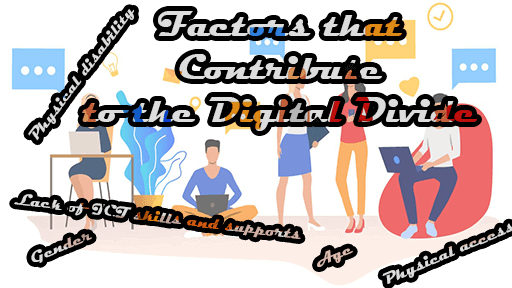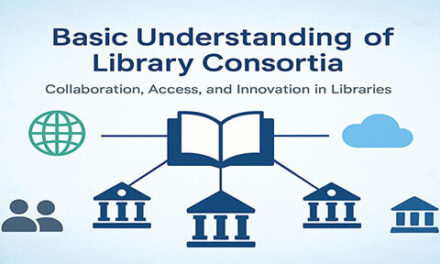The digital divide refers to the gap between those who have access to digital technologies, such as computers, smartphones, and the internet, and those who do not. This divide can exist on various levels, including geographic location, income, education level, age, and race. Those who lack access to digital technologies may be unable to take advantage of the opportunities offered by the digital age, such as online education, remote work, and digital services. This can lead to further disadvantages and disparities in opportunities and outcomes between different groups of people. Efforts to bridge the digital divide can involve policies and initiatives aimed at increasing access to digital technologies, as well as improving digital literacy skills, and addressing other barriers to adoption. In the rest of this article, we will discuss the digital divide, the effects & stages of the digital divide, factors that contribute to the digital divide, barriers to bridging the digital divide, role of libraries in bridging the digital divide.
Definitions of Digital Divide:
Here are some definitions of the digital divide from different writer’s perspectives:
The Organization for Economic Co-operation and Development (OECD) defines the digital divide as “the gap between individuals, households, businesses, and geographic areas at different socio-economic levels with respect to their opportunities to access information and communication technologies (ICTs) and to their use of the internet for a wide variety of activities.”
According to the World Bank, the digital divide is “the gap between individuals, households, businesses, and geographic areas at different socio-economic levels with regard both to their opportunities to access information and communication technologies (ICTs) and to their use of the internet for a wide range of activities.”
In their book “Bridging the Digital Divide,” authors Martin Hilbert and Priscila López define the digital divide as “the unequal distribution of information and communication technologies among individuals, households, businesses, and geographic areas.”
The United Nations defines the digital divide as “the gap between those who have access to information and communication technology (ICT) and those who do not. It is also the gap between those who have the skills to use ICTs effectively and those who do not.”
In his article “The Digital Divide: A Global Perspective,” researcher Stephen Ruth defines the digital divide as “a term that refers to the gap between those who have access to digital technologies and those who do not. This gap can be seen in terms of both the availability of technology and the ability to use it effectively.”
From the above definitions, we can say that the digital divide refers to the gap between those who have access to digital technologies and those who do not, and this gap can exist on various levels, including socioeconomic status, geographic location, and digital literacy skills.
Effects of Digital Divide:
The digital divide can have significant impacts on individuals, communities, and societies. Here are some effects of the digital divide:
- Educational disparities: The digital divide can contribute to educational disparities, as students without access to digital technologies and the internet may be unable to access online educational resources and tools. This can further widen the achievement gap between low-income and high-income students (Hilbert & López, 2011).
- Economic inequalities: Lack of access to digital technologies can limit individuals’ job opportunities, as many jobs require digital literacy skills and the ability to work remotely. This can further exacerbate economic inequalities between different groups of people (World Bank, 2016).
- Social isolation: Individuals without access to digital technologies may be unable to connect with others online, leading to social isolation and loneliness. This can be especially impactful for older adults, who may be unable to access telehealth services and other forms of digital support (Ruth, 2008).
- Political disenfranchisement: The digital divide can lead to political disenfranchisement, as individuals without access to digital technologies may be unable to access online voting systems or participate in online political discourse. This can further widen the gap between those who have a voice in the political process and those who do not (OECD, 2001).
- Healthcare disparities: Lack of access to digital technologies can limit individuals’ ability to access telehealth services and other forms of digital healthcare support. This can further exacerbate healthcare disparities between different groups of people (World Health Organization, 2021).
In summary, the digital divide can have wide-ranging impacts on individuals, communities, and societies, contributing to educational disparities, economic inequalities, social isolation, political disenfranchisement, and healthcare disparities. Efforts to bridge the digital divide can help to mitigate these effects and promote greater equity and inclusion in the digital age.
Stages of Digital Divide:
The digital divide can be understood as a multi-faceted and complex phenomenon that involves inequalities in access to and use of digital technologies and the internet. Scholars have identified several stages or dimensions of the digital divide that reflect different aspects of these inequalities. Here are some of the key stages:
- Economic divide: One of the most widely recognized dimensions of the digital divide is the economic divide, which refers to inequalities in access to digital technologies and the internet based on income and wealth. People with low incomes or limited financial resources may be less likely to have access to digital devices, internet services, and other digital tools and resources, which can limit their ability to participate in the digital economy and society (Norris, 2001).
- Usability divide: Another dimension of the digital divide is the usability divide, which refers to inequalities in digital skills and literacy. People who lack digital literacy and skills may have difficulty using digital tools and resources, navigating online platforms, and accessing relevant digital content. This can limit their ability to engage in online activities, such as online learning, job searches, and social networking (Hargittai, 2002).
- Empowerment divide: The empowerment divide is a third dimension of the digital divide that focuses on the social and political implications of digital technologies and the internet. This dimension recognizes that digital technologies can provide new opportunities for political participation, civic engagement, and social activism, but also that these opportunities are not equally available to all individuals and groups. The empowerment divide highlights the importance of access to digital technologies and the internet for promoting democratic participation and social justice (Van Dijk, 2005).
Factors that Contribute to the Digital Divide:
There are many factors that contribute to the digital divide, creating inequalities in access to digital technologies and the internet. Some of the key factors are given below;
- Gender: Women may be less likely to have access to digital technologies and the internet due to societal and cultural barriers, such as gender norms and expectations. In some cases, women may also have limited financial resources or may be denied access to education and training opportunities that can help to build digital skills (OECD, 2020).
- Physical disability: Individuals with physical disabilities may face physical barriers to accessing digital technologies, such as difficulty using a computer or navigating a website. This can be compounded by a lack of assistive technologies and accessible digital content (ITU, 2021).
- Physical access: Individuals living in rural or remote areas may have limited access to digital technologies and the internet due to limited infrastructure and connectivity. This can be compounded by a lack of affordable and reliable internet service providers (World Bank, 2016).
- Lack of ICT skills and supports: Individuals without digital skills or training may be unable to effectively use digital technologies and the internet, limiting their ability to access information, participate in online communities, and take advantage of digital opportunities. This can be compounded by a lack of digital literacy programs and support networks (Hilbert & López, 2011).
- Attitudinal factors: Some individuals may be resistant to using digital technologies and the internet due to concerns about privacy, security, and the authenticity of online content. Others may feel that digital technologies are not relevant to their lives or interests (Van Dijk, 2012).
- Relevant content: Individuals may be less likely to use digital technologies and the internet if the content is not relevant to their needs and interests. This can be compounded by a lack of locally relevant content and services (World Bank, 2016).
- Age: Older adults may be less likely to have access to digital technologies and the internet due to limited digital skills and a lack of familiarity with new technologies. This can be compounded by a lack of tailored digital training programs and support networks (Pew Research Center, 2021).
- Racial segregation: Certain racial and ethnic groups may be less likely to have access to digital technologies and the internet due to historical and systemic inequalities, such as discriminatory housing policies and limited access to education and job opportunities (National Digital Inclusion Alliance, 2021).
Overall, these factors and others can contribute to the digital divide, creating inequalities in access to digital technologies and the internet. Efforts to bridge the digital divide must take these factors into account and work to address them in order to promote greater equity and inclusion in the digital age.
Barriers to Bridging the Digital Divide:
Despite the recognition of the digital divide and its negative impacts on individuals and societies, there are still several barriers that hinder efforts to bridge the divide. These barriers can be categorized into several types, including infrastructural, language, literacy and skills, economic, and content barriers. Here’s a closer look at each type:
- Infrastructural barriers: One major barrier to bridging the digital divide is the lack of adequate technological infrastructure, such as broadband internet, in some areas. In rural or remote areas, for example, the cost of building infrastructure may be prohibitively high, leading to a lack of access to high-speed internet and other digital technologies (Van Dijk, 2012). Additionally, infrastructure may be lacking in urban areas for marginalized communities, such as low-income or minority populations, leading to further inequalities in access (Warschauer & Matuchniak, 2010).
- Language barriers: Language can also be a barrier to bridging the digital divide. Many digital technologies and online content are available only in certain languages, which can limit access and participation for individuals who do not speak those languages (Warschauer & Matuchniak, 2010). This can be especially challenging for individuals from non-English-speaking backgrounds, who may face additional barriers to digital access and participation (Perrin & Duggan, 2015).
- Literacy and skills barriers: Another significant barrier to bridging the digital divide is the lack of digital literacy and skills. Many people lack the basic digital literacy skills needed to navigate online platforms and use digital tools effectively (DiMaggio & Hargittai, 2001). This can limit their ability to access online information and resources, engage in online learning or job searches, and participate in other digital activities.
- Economic barriers: Economic factors can also pose a significant barrier to bridging the digital divide. The cost of digital technologies, such as computers and internet service, can be prohibitively high for individuals with limited financial resources (Van Dijk, 2012). In addition, the cost of digital skills training and education can also be a barrier for some individuals.
- Content barriers: Content can also be a barrier to bridging the digital divide. The lack of relevant or useful digital content can limit the ability of individuals to fully participate in the digital age (Warschauer & Matuchniak, 2010). For example, individuals may lack access to online educational resources in their preferred language or may not be able to find relevant job opportunities online.
- Social and cultural barriers: Social and cultural factors can also play a significant role in creating and maintaining the digital divide. For example, gender and race can influence access to digital technologies and the internet, with women and minorities often having less access and facing more barriers to digital participation (Warschauer & Matuchniak, 2010). Additionally, attitudinal factors, such as a lack of interest or motivation, can limit individuals’ engagement with digital technologies (DiMaggio & Hargittai, 2001).
- Political and policy barriers: Political and policy barriers can also hinder efforts to bridge the digital divide. For example, some governments may prioritize digital infrastructure development in certain areas over others, leading to further inequalities in access (Van Dijk, 2012). In addition, policies that restrict or censor online content can limit individuals’ access to information and resources, further exacerbating the digital divide.
- Privacy and security concerns: Finally, privacy and security concerns can also be a barrier to bridging the digital divide. Individuals who lack trust in digital technologies may be less likely to use them, particularly if they are concerned about the privacy and security of their personal information (Warschauer & Matuchniak, 2010).
Addressing these barriers will require a multi-faceted approach that takes into account the complex interplay between technological, social, cultural, political, and economic factors. Effective strategies will need to prioritize access to digital technologies and infrastructure, as well as digital skills training and education, while also addressing the social and cultural barriers that can limit participation. Additionally, policies that promote greater equity and inclusion in the digital age will be essential for bridging the divide and ensuring that all individuals have the opportunity to benefit from the many advantages that digital technologies can offer.
Role of Libraries in Bridging the Digital Divide:
Libraries play a crucial role in bridging the digital divide, which refers to the gap between those who have access to digital technologies and those who do not. This divide has serious implications for education, economic opportunity, and social mobility, particularly in low-income and underserved communities. Here we will examine the various ways in which libraries serve as a bridge to digital inclusion, citing relevant studies and experts in the field.
Firstly, libraries provide access to digital technologies and the internet, particularly to those who cannot afford to have them at home. According to a survey conducted by the Pew Research Center, almost one-third of Americans do not have broadband internet access at home, and this proportion is higher among low-income households and rural communities (Perrin, 2019). Libraries offer free access to computers, Wi-Fi, and other digital technologies, which is particularly important for students who need to complete homework or online assignments.
In addition to providing access, libraries also offer digital literacy training to help people navigate and use digital technologies effectively. The American Library Association (ALA) defines digital literacy as “the ability to use information and communication technologies to find, evaluate, create, and communicate information, requiring both cognitive and technical skills” (ALA, 2013). Digital literacy is becoming increasingly important in the 21st century, as many jobs and daily tasks require digital skills. Libraries offer workshops, classes, and one-on-one assistance to help people develop these skills.
Moreover, libraries also serve as community hubs, where people can gather to access information, resources, and services. This is particularly important for low-income and underserved communities, which may lack other community spaces. According to a report by the Institute of Museum and Library Services (IMLS), libraries are “essential anchors for vibrant communities” that provide “access to knowledge, resources, and opportunities” (IMLS, 2018). Libraries offer a wide range of services, including job search assistance, legal aid, health information, and social services referrals.
Furthermore, libraries also play a role in promoting digital equity and addressing systemic inequalities. As public institutions, libraries are committed to providing equal access to information and services for all members of the community, regardless of socioeconomic status, race, gender, or other factors. Libraries have a long history of promoting social justice and serving as advocates for marginalized communities. According to a report by the ALA, “libraries are at the forefront of the fight for digital equity” (ALA, 2017). Libraries work with community partners to address the root causes of the digital divide, such as poverty, lack of infrastructure, and inadequate funding for education.
Overall, libraries play a vital role in bridging the digital divide by providing access to digital technologies and the internet, offering digital literacy training, serving as community hubs, and promoting digital equity. Libraries are uniquely positioned to address the digital divide and to help create more equitable and inclusive communities. As the IMLS notes, “libraries are places of opportunity that support individuals in their pursuit of education, workforce development, and personal enrichment, as well as spaces that provide support and services to help people overcome challenges” (IMLS, 2018).
References:
- American Library Association. (2013). Digital Literacy. Retrieved from https://www.ala.org/tools/librariestransform/digital-literacy
- American Library Association. (2017). Digital Equity. Retrieved from https://www.ala.org/advocacy/diversity/equityofaccess/digital-equity
- DiMaggio, P., & Hargittai, E. (2001). From the ‘digital divide’ to ‘digital inequality’: Studying Internet use as penetration increases. Princeton Center for Arts and Cultural Policy Studies, Working Paper.
- Hargittai, E. (2002). Second-level digital divide: Differences in people’s online skills. First Monday, 7(4).
- Hilbert, M. & López, P. (2011). The World’s Technological Capacity to Store, Communicate and Compute Information. Science, 332(6025), 60-65.
- Institute of Museum and Library Services. (2018). The State of America’s Libraries. Retrieved from https://www.imls.gov/sites/default/files/state-of-americas-libraries-report_0.pdf
- ITU (2021). Measuring Digital Development: Facts and Figures 2021. Geneva: International Telecommunication Union.
- National Digital Inclusion Alliance (2021). Digital Equity: An Overview. Retrieved from https://www.digitalinclusion.org/digital-equity/
- Norris, P. (2001). Digital divide? Civic engagement, information poverty, and the internet in democratic societies. Cambridge University Press.
- OECD (2001). Understanding the Digital Divide. Paris: OECD Publishing.
- OECD (2020). Bridging the Digital Gender Divide: Include, Upskill, Innovate. Paris: OECD Publishing.
- Perrin, A., & Duggan, M. (2015). Americans’ internet access: 2000-2015. Pew Research Center.
- Perrin, A. (2019). Digital gap narrows, but Americans who don’t use the internet remain offline. Pew Research Center. Retrieved from https://www.pewresearch.org/fact-tank/2019/04/22/some-americans-dont-use-the-internet-who-are-they/
- Pew Research Center (2021). Technology Use and Attitudes among Mid-Life and Older Americans. Retrieved from https://www.pewresearch.org/internet/2021/04/07/technology-use-and-attitudes-among-mid-life-and-older-americans/
- Ruth, S. (2008). The Digital Divide: A Global Perspective. Information Society, 24(5), 231-239.
- Van Dijk, J. (2005). The Deepening Divide: Inequality in the Information Society. Sage Publications.
- Van Dijk, J. (2012). The Evolution of the Digital Divide: The Digital Divide Turns to Inequality of Skills and Usage. In Hargittai, E. & Shaw, A. (Eds.), Digital Inequality: Emerging Inequalities in Access to the Internet and ICT Usage (pp. 1-22). New York: Routledge.
- Van Dijk, J. (2012). The evolution of the digital divide: The digital divide turns to inequality of skills and usage. In T. K. Sen, P. Maiti, & P. Basu (Eds.), Digital divide: Issues, challenges and solutions (pp. 25-39). Springer.
- Warschauer, M., & Matuchniak, T. (2010). New technology and digital worlds: Analyzing evidence of equity in access, use, and outcomes. Review of Research in Education, 34
- World Bank (2016). World Development Report 2016: Digital Dividends. Washington, DC: World Bank Group.
- World Health Organization (2021). WHO guideline: recommendations on digital interventions for health system strengthening. Geneva: World Health Organization.

Library Lecturer at Nurul Amin Degree College










